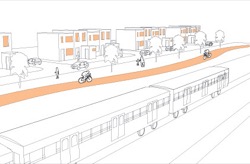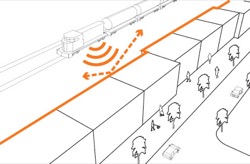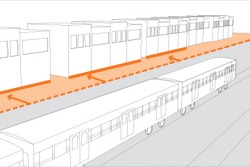On this page:
About railway corridor environs
Railway corridor environs focuses on land and activities adjacent to the railway operating corridor. Along the length of the corridor, adjacent land may accommodate a variety of uses including:
- streets and roads
- public open space
- residential or commercial development.
Railway corridors contribute to an effective movement network. Railway corridors may carry metropolitan passenger, regional passenger or freight trains. Railway corridor crossing points channel and concentrate pedestrian, bicycle and vehicle movement to specific locations.
Railway crossing points are used by both commuters and the general public. Crossing points can be existing at–grade or new grade–separated crossings. Grade separated crossings are either by an underpass (subway) or an overpass (footbridge).
The design of new transport routes and new developments, where applicable, must provide for grade separation at railway crossings except with the approval of the Minister for Public Transport.
Why is it important?
Some railway corridors, due to their length and widely-spaced safe crossing points, can be a barrier to movement in the wider area. Space adjacent to the railway operating corridor, if safely separated, can provide opportunities for linear open space, and pedestrian and bicycle paths. Railway stations and crossing points along the corridor can be locations for more intense activity.
Some train operations can result in noise and vibration effects on nearby properties, especially where a freight service operates or the track curves or climbs, or where there is a signalised level crossing. Development within the railway corridor environs should consider the potential amenity impacts of the railway operating corridor, and constraints on public access.
This element provides design guidance for the immediate surroundings of railway corridors. It does not include design considerations within the operational rail corridor. The engineering, servicing or management issues of the public transport modes are guided by other appropriate authorities. Refer to Public Transport Guidelines for Land Use and Development.
4.4.1: enhance connectivity and access in railway corridor environs
- Provide conveniently located grade separated pedestrian and bicycle crossings across railway corridors, motorways and other natural barriers, to connect neighbourhoods and key destinations.
Tip: in urban areas, the crossing location and frequency should be informed by local circumstances and need. The design of transport routes at new developments must provide for future grade separation at railway crossings except with the approval of the Minister for Public Transport.
4.4.2: enhance the amenity and safety for adjacent uses in the railway corridor environs
Railway corridors are not public spaces. However, as there is no requirement on the railway operator to fence the railway track area, the railway operating corridor may sometimes appear as quasi-public space, in particular where it is adjacent to a public road or actual public space.
Development adjacent to a rail corridor should include suitable fencing to prevent access to the corridor. Advice from the rail track authority is to treat rail land as private property, unless advised otherwise by the authority.
- Where a railway operating corridor serves only metropolitan passenger services, provide a street between the railway operating corridor and the surrounding area, to provide an active frontage.

Tip: a street is not an effective noise buffer, but metropolitan services generally make less noise than diesel freight trains. - Where a railway operating corridor serves freight or regional passenger services, design buildings or structures to provide a noise buffer for adjacent buildings and the surrounding area.

Tip: while buildings designed to provide a noise and vibration barrier are appropriate in freight or regional passenger corridors, sound walls, if well designed, may also be a solution. - Where a private lot abuts a railway corridor, set buildings back from the boundary with the railway property.

Tip: avoid building to the lot boundary on the railway land interface. Railway property is not usable as a public way or for providing access to daylight and ventilation in adjacent buildings. Set buildings a sufficient distance back from the boundary to provide access for maintenance and repairs to buildings and services, and to allow for light and ventilation access for the building. - Where a building wall faces a railway corridor, design the building facade to dissipate noise.
Tip: faceting the building wall, or using a sound-absorbing surface finish can reduce noise transmission into bordering buildings.
- Where a building wall or fence interfaces a railway corridor, use wall and fence finishes that resist graffiti and vandalism.
Tip: while vegetation on walls discourages graffiti, maintaining the plantings is an additional management cost and responsibility.
4.4.3: ensure buildings and uses adjacent to the railway corridor support safe railway operations
- Locate trees and planting along railway corridors to maintain clear sightlines for train drivers, and to ensure branches do not fall onto the rail infrastructure.
Tip: maintaining clear sightlines between an adjacent path and the rail operating corridor also ensures that pedestrians and cyclists can see approaching trains.
- Use visually non-reflective surfaces on buildings and structures facing the railway corridor to avoid glare and train driver distraction.
- Shield the railway operating corridor from light spill from adjacent properties to avoid train driver distraction.
Tip: train driver distraction, caused by bright lights, colours or shiny surfaces, can pose safety risks to train operations.
4.4.4: ensure effective place maintenance in railway corridor environs
- Where development or works are proposed on land abutting a railway corridor, consult with railway agencies early in the planning process.
- Establish a place management agreement that identifies management and maintenance responsibilities and processes.
Tip: railway corridor environs are complex areas to manage. A place management agreement and place maintenance processes can provide for coordination and consistency.
Page last updated: 09/06/23